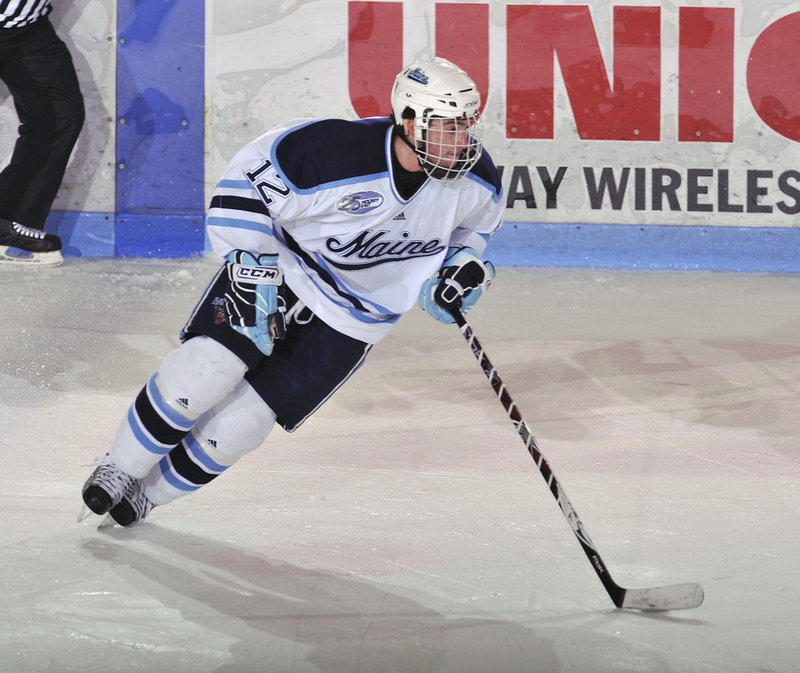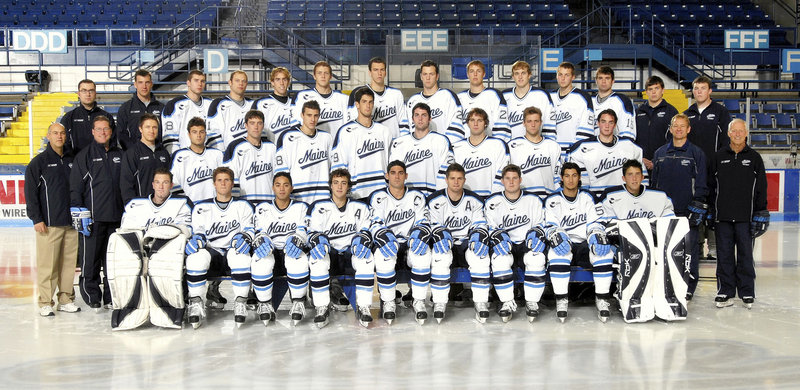A former University of Maine student-athlete has become the first hockey player to join a class-action lawsuit that claims the National Collegiate Athletic Association has failed to do enough to address and prevent concussions.
Kyle Solomon, 25, of Southampton, N.Y., was a member of UMaine’s hockey team from 2008 to 2010. He left the team in the middle of his sophomore season after suffering a series of head injuries.
This week, Solomon added his name to a lawsuit filed in September 2011 in U.S. District Court in Northern Illinois.
The lawsuit includes three other former student-athletes who suffered career-ending concussions: Adrian Arrington, who played football for Eastern Illinois University; Derek Owens, who played football for the University of Central Arkansas; and Angela Palacios, who played soccer at Ouachita Baptist University in Arkansas.
Solomon did not return several calls for comment Thursday and Friday. The lawsuit details his history playing for UMaine.
Before joining the team in 2008, Solomon disclosed to UMaine’s coaching staff that he had suffered three concussions during his prep career.
“Neither the coaching or (sic) training staff ever addressed or discussed concussions or concussion symptoms with him,” the complaint reads. “He also did not receive any information from or on behalf of the NCAA on how to recognize or report head injuries.”
Solomon’s first concussion at UMaine came during a practice in March 2009, when a teammate elbowed him in the head. When he tried to get up after the hit, his legs collapsed and he felt dizzy, the complaint says. The symptoms lasted several days.
In a nationally televised game between Maine and Boston College in October 2009, Solomon was hit by an opposing player. The collision sent Solomon toward the boards, where he hit his head above the right ear and blacked out.
When he regained consciousness, he saw “stars” and had double vision, the complaint reads. A trainer examined Solomon in the locker room but did not diagnose a concussion. Solomon was given seven stitches and returned to the game in the third period.
After the game, “Solomon was told to ‘go back to his dorm room and rest,’ despite the fact that he lived alone and no one was present to monitor his condition,” the complaint reads. He continued to experience concussion symptoms for about a week.
In January 2010, in a game between Maine and Merrimack College, Solomon was elbowed again. He left that game in an ambulance and was treated at a hospital for damage to his vocal cords and a slight concussion. He was out of action for about two weeks.
Solomon’s final head injury came during a practice in March 2010, when he was “elbowed softly” by a teammate, the complaint reads. He was diagnosed with a concussion but was cleared to return two weeks later, “despite the fact that Solomon felt something was wrong with him. He felt like a different person. He noticed a change in his personality, felt depressed, and was disconnected with reality.”
After that hit, Solomon visited Dr. Robert Cantu, a neurologist in Boston who specializes in brain injuries. Cantu told Solomon that his brain had sustained severe trauma and “advised that another concussion could kill him,” the complaint says.
Solomon retired from hockey.
He has continued his studies at UMaine but the effects of his concussions have been debilitating, the complaint says. He can’t read for long stretches, suffers from migraine headaches and often cannot sleep.
The three other student-athletes named in the lawsuit have similar stories.
“While playing NCAA sports, the NCAA did not encourage Arrington, Owens, Palacios, Solomon or other student-athletes to report or complain about their physical well-being, did not thoroughly educate (them) of the long-term effects of concussions, and did not thoroughly educate plaintiffs or other student-athletes about head-injury prevention,” the complaint reads.
The lawsuit seeks compensatory damages, “the amount of which is to be determined at trial,” and calls for adoption of a series of preventive measures and the creation of a medical monitoring program for college athletes.
Laura Reed, spokeswoman for the University of Maine athletic department, said the university could not comment on Solomon’s time at Maine because of health privacy laws. She did not respond to requests for comment about concussions related to the UMaine hockey program.
The NCAA also did not respond Friday to a request for comment. In its response to the original complaint, filed on Dec. 21, 2011, the organization said it was “without knowledge or information sufficient to form a belief as to the truth or falsity of the allegations.”
The NCAA has not responded to the amended complaint, which was filed this week.
UMaine coach Tim Whitehead remembers Solomon as a tough, hard-nosed player who suffered concussions before joining Maine’s hockey team. He said in an interview Thursday that he was not aware that Solomon had become a plaintiff in the NCAA lawsuit.
“He played the game hard, so it wasn’t like he could avoid contact,” Whitehead said. “We really felt for him, but the decision to play again was clear … it was not worth the risk.”
Whitehead said his team has had its share of concussion-related injuries this season.
Four players have had to miss games or are currently out with concussions. They include Kyle Beattie, a senior center who is out indefinitely with his third concussion of the season.
“It’s not a problem that is going away,” Whitehead said. “A helmet is only going to do so much.”
He said one issue that the NCAA must address is players trying to hide concussion symptoms from their coaches. Some players want to maximize their ice time even if it means putting their bodies at risk, he said. “We need to find a way to increase player awareness.”
Before the season, each player gets a baseline cognitive ability test, which can be reviewed if a player suffers a concussion. But Whitehead said the test is no good if a player tries to hide concussion symptoms.
Whitehead said the speed of the game has increased in recent years, and the plastic in protective equipment is much harder than materials used in the past. Those factors, he believes, have led to more concussions.
“The one thing that hasn’t changed is the brain,” he said.
Paul Greene, a Portland lawyer who has represented collegiate and professional athletes and teaches sports law at the University of Maine School of Law, said the lawsuit will come down to what the NCAA’s duty is to student athletes.
“I don’t think it’s unreasonable that the NCAA should have regulations in place about concussions,” Greene said Friday. “The NCAA has a 450-page manual that directs schools in every other capacity. It has never been averse to regulation.” He predicted that the class-action suit will drag on for months, possibly years, and may never go to trial. But he said that in such cases, the outcome is often less important than the public debate.
— Staff Writer Dennis Hoey contributed to this report.
Eric Russell can be contacted at 791-6344 or at:
erussell@pressherald.com
Twitter: @PPHEricRussell
Send questions/comments to the editors.





Success. Please wait for the page to reload. If the page does not reload within 5 seconds, please refresh the page.
Enter your email and password to access comments.
Hi, to comment on stories you must . This profile is in addition to your subscription and website login.
Already have a commenting profile? .
Invalid username/password.
Please check your email to confirm and complete your registration.
Only subscribers are eligible to post comments. Please subscribe or login first for digital access. Here’s why.
Use the form below to reset your password. When you've submitted your account email, we will send an email with a reset code.